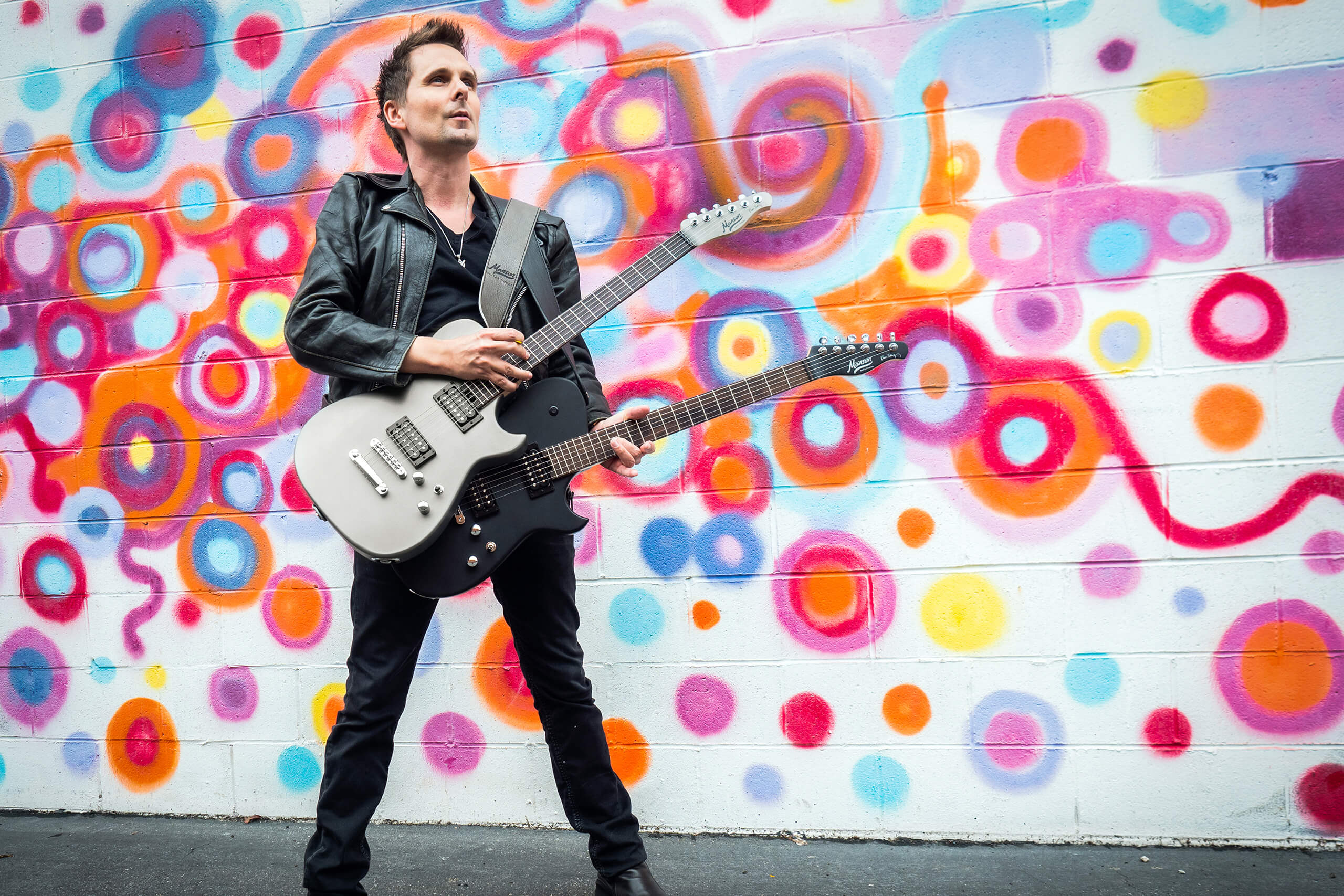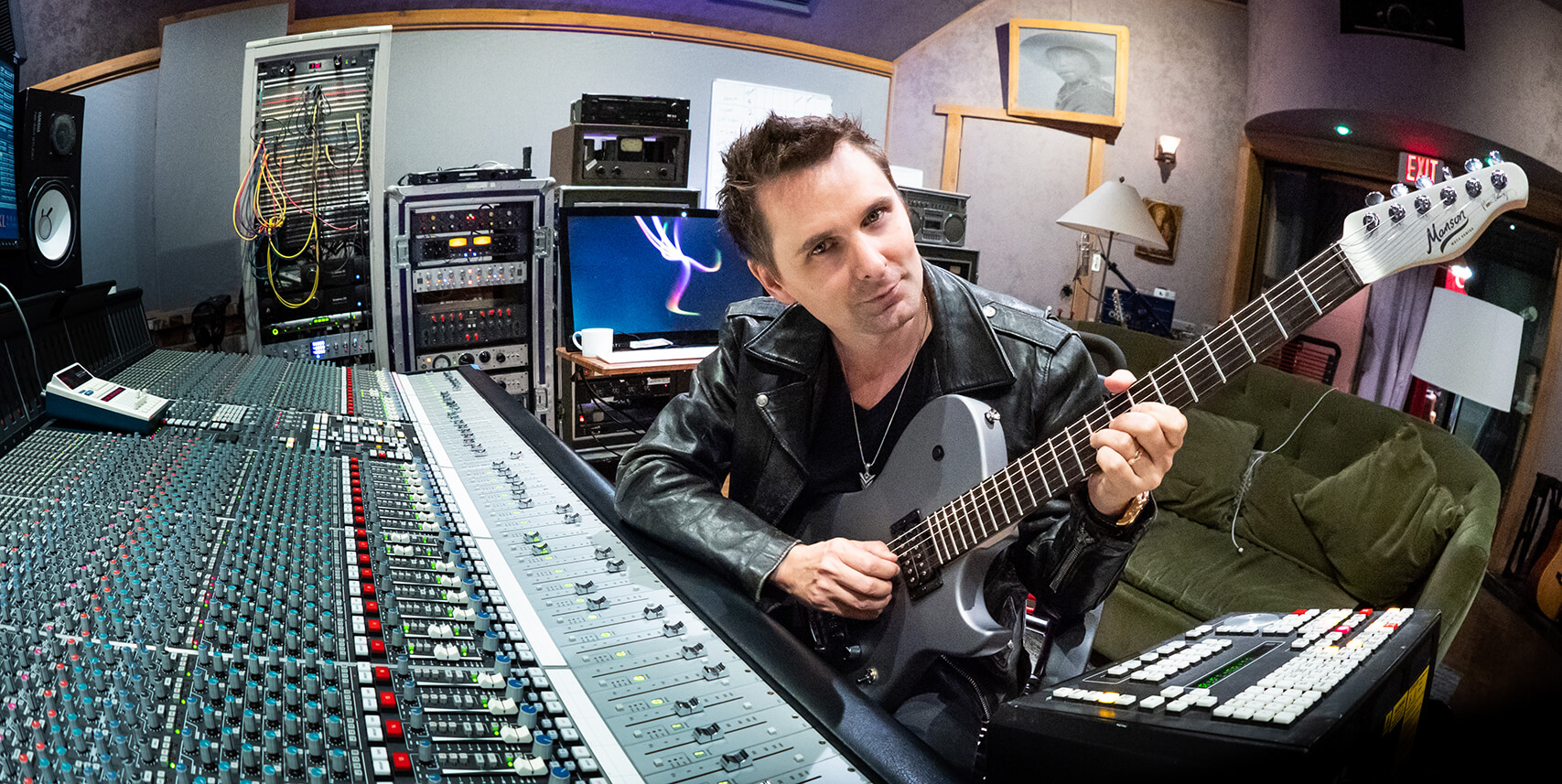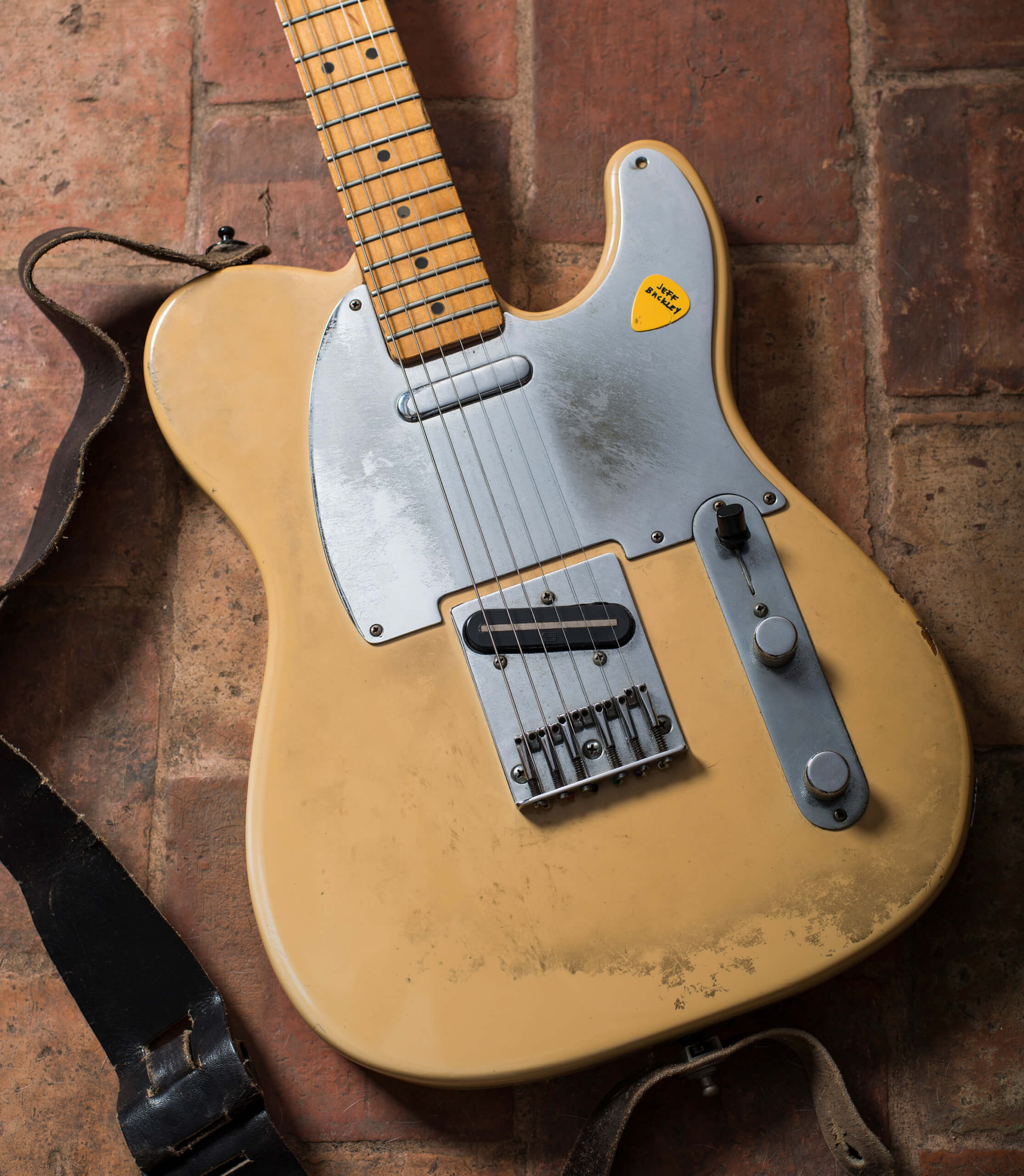“I wanted a guitar that would lead me down a path of 21st-century music”: Matt Bellamy on Manson Guitar Works
The Muse frontman on Manson Guitar Works, Billie Eilish and the dark art of creating colossal distortion tones.

Image: Jolyon Holroyd
Bumping into guitar gods at NAMM is nothing new but there was a time when the show was probably regarded as too ‘muso’ for alternative-rock stars to frequent. In recent years things have changed. Instagram has created a petri dish in which the relationships between hip young artists and gear companies have flourished into full-blown collaborations, while at the high-dollar end of the spectrum, stadium-filling guitarists such as Ed Sheeran and Matt Bellamy have invested in long-established guitar companies. In simple terms, the shredders and metalheads are no longer the biggest kids in the playground.
Back in January, before the world closed its doors, we were ushered into a tiny room barely insulated from the maelstrom of the NAMM show floor for an audience with the aforementioned Muse frontman. After tearing up stages and charts across the globe for more than 20 years, 2019 saw Bellamy smash his piggy bank and purchase a majority shareholding in Devon’s Manson Guitar Works. It made perfect sense – the interstellar tones of tricked-out Manson electrics have driven Muse’s biggest hits and helped give Bellamy a guitar identity all of his own.

With founder Hugh Manson set to move into a consultancy role to allow for semi-retirement, Bellamy and CEO Adrian Ashton are geared up to pen a new chapter for the Manson brand. Their first step was to announce the affordable Meta Series MBM-1 model and it’s the fanfare surrounding its release that brings Bellamy to the social event of the season for the guitar industry.
“It’s nice to be able to launch in a low-price range,” says Matt as we admire one of the prototypes. “It’s our design but we’re getting the manufacturing done by Cort to bring prices down and help with distribution. Manson is obviously associated with high-end, hand-made guitars so it was a bit of a step, I think, for us to take the plunge into the lower price range. But we’re approving everything before it goes out. It really is the best guitar we can make for this price. Every time I go on social media, there’s people saying, ‘Make a bloody Manson for less than a grand’, so it’s nice to be able to do that.”
“Getting new and fascinating guitar sounds is becoming even more challenging and important”
As with any signature instrument, people may be sceptical about how close the production version is to the guitars Bellamy uses on stage but he describes it as “pretty much identical” when it comes to sound and feel. “The ultimate test is, is it something I would use on stage?” he says. “And the answer is yes. I’m going to have a bunch of these on tour next time I go out. Without sounding too destructive, obviously I do throw my guitars around a lot, so having ones in this price range makes it slightly less scary.
“Having said that, people see me lob my guitars around on stage a lot – we send the parts back for repair and most of the time, worst-case scenario is a new neck. I’ll do maybe seven or eight shows where I lob them around and they land on an amp or on stage and they just don’t break at all. They are really, really strong.
“People think I trash a lot of guitars on tour but it’s just not true – I’ve probably thrown the most guitars but you pick them up and they still work. The Manson guitars were designed to deal with that kind of treatment so they are really hard-wearing.”

Hyper music
Roadworthiness aside, although the debut model in the Meta Series features no onboard gadgets other than a kill button for stutter effects, Bellamy says that this may change as the line progresses. “We’re starting out with a pretty simple one. As time goes on, we might start introducing some other built-in effects and so on, different pickup variations, different colours. We’re constantly experimenting and doing new things.
“For a while, with Manson, we’ve been doing the guitars that have Kaoss Pads built in – I really like the idea of being able to bring one out that has built-in stuff, so straight out of the box you can do cool tricks with the XY controller. One of the things we’re doing while we’re here is chatting about doing a collaborative guitar that has the Whammy components in it, so all that pitch-shifting and crazy stuff you can just do right there without any outboard effects.”

When this kind of onboard tech becomes accessible to the masses, we wonder if Bellamy will have to find a whole new playbook in order to stay one step ahead of copyists. “If anybody ever copies anything you do, I think that’s a compliment,” he says, with a grin. “It’s a sign that you’ve done something new or different. We were probably the first to have the XY controller onboard, and I’ve seen a few others floating around now. Fender called me in for a meeting once and showed me something they were working on and I was like, ‘Nah, I’m with Manson, leave me alone!’”
Although the boutique-effects boom has seen more players approach the guitar like a controller than ever before, Bellamy still feels that the geometry and ergonomics of an instrument have a significant impact on the compositions it inspires. “With effects, you can go in any direction you want to now,” he says. “But, fundamentally, the way a guitar feels is so important. When I was younger and I picked up a Strat or a Gibson or something like that, it would always send me down a certain way of playing, which I felt was less original than when playing my own design.
“I really like Billie Eilish – that dark atmosphere she creates is something I can really connect with”
“When I pick up this guitar, it makes me play the way I play and come up with the ideas I come up with that are different to when I play any other type of guitar. That’s all to do with feel. To some extent, you can go anywhere you want with sounds now but I still think the way a guitar feels is important. It directs the way you play. I wanted to come up with a guitar that would lead me down a path of 21st-century music rather than going backwards with a retro feel. That’s always been the challenge with the guitar in the modern era of music.”
All that said, Bellamy recently purchased the famous 1983 Telecaster Jeff Buckley used throughout his brief but incandescent career. Buckley’s influence can of course be heard in Bellamy’s soaring falsetto vocals, but the Muse frontman seems intent on buying the guitar as more than just a trophy.
“I’m thinking I might try and have a play with it in the studio and see how it sounds,” he says. “Despite what I was saying a minute ago, we’ve actually been discussing doing a retro-style or retro-sounding Manson. We may actually base some of it on the Jeff Buckley guitar.”

Bellamy’s signature Mansons have always seemed like a highly evolved, aggressive take on Fender’s iconic single-cut, so perhaps it isn’t too hard to imagine. “When I first came in 20 years ago, I was torn between an SG and the Telecaster-type shape, feel, sound and everything,” Bellamy recalls. “I really wanted something that was in the middle of those two in terms of body shape, feel and sound.”
We imagine that the way the guitar sounded in the context of a power trio was also a key consideration in those early days. “Yeah, you want something on the chunky side,” says Bellamy. “Those Fender-type sounds can be too thin to fill the space in a three-piece band. Having said that, I don’t play powerchords that much – I try to play lead parts or single note parts a lot, so you need a sound that’s thick in tone and broad, and not plinky and thin.”
Plug-in babies
When it comes to amp tones, the Muse star also takes a hybrid approach, using Kemper profiles that he created in the studio while out on tour. “There are models based on vintage Vox AC30s from 1964, plus a Marshall JTM45 sound, and a Diezel,” says Bellamy. “A lot of the sounds I use actually blend those three together. Even on stage I tend to use two Kempers side by side in stereo. If I’ve got a Marshall tone, there will be a Vox that goes alongside it. Even though the real amps sound better, the user-friendly nature of Kemper makes it flexible on stage, especially if you’re doing multiple changes within songs.”

As well as that trio of amp tones, Bellamy typically uses six or seven other unique models, including direct fuzz tones. “I use a lot of DI’d fuzz sounds on stage – throughout any one show I’m probably working through up to 10 different amp sounds,” he says. “My theory is that the frequency range that the distorted guitar hits starts to lose its impact after about five to 10 minutes. If you don’t change the phase or attack of it, that powerful effect that you want the guitar to have when you first strum a chord? Cut to 10 minutes later and it’s just white noise.
“Throughout the set I tend to evolve the modelled amp sounds to be completely different. Song six in the setlist will have a completely different tone to the first song. The idea is it still has the same impact as the set develops. I’ve always been more on the amp-crunch side than pedals. I’ve never been a big user of crunch pedals going into amps. Whenever I use pedals, I tend to like them as a DI sound, like the crazy fuzzes. That’s why I’ve gone down the Kemper route, to have so many different types of modelled amp sounds. Some people would use a cleaner amp tone and lots of different pedals to get different tones but I tend to use different amps.”
“we’ve actually been discussing doing a retro-style or retro-sounding Manson. We may base some of it on the Jeff Buckley guitar”
Despite all the digital modelling tech and DI fuzz he employs, part of the magic of Bellamy’s huge live sound still relies on hot glass bottles and moving air. “I actually have a Diezel running as well,” he says, “so my onstage cabinet is blasting out Diezel sounds. It has four channels, which is handy. I have channel one as a dead clean sound, so whenever I’m using a DI fuzz into the PA system, I’ll have that same fuzz going into channel one of the Diezel on stage. Channel two I get to sound like a Vox, channel three more like a Marshall, and channel four like a high-gain metal sound. And I have that blasting out of the speakers behind me.
“That plays into the sound a lot because my vocal mic is quite loud and it picks up a lot of that bleed. That’s important. For TV performances, they always want you to have your amps either off or down. I’ve noticed that, for a rock band, if you do that you end up with loads of cymbal noise coming down your microphone and it sounds terrible. I’ve learnt that you need a loud 4×12 on stage behind you, otherwise the blend with the microphone sound and the cymbals doesn’t match up right.”

New born
Although Bellamy is currently taking time out between album cycles to build a recording studio in Santa Monica – and he admits that aside from hundreds of days of sunshine every year, the proximity to some of his favourite restaurants is a big part of the location’s appeal – we wonder if any new musical influences are seeping in, and whether they will affect the direction of Muse’s ninth studio LP when the band begins working on it in 2021.
“I know she’s the biggest artist in the world right now but I like Billie Eilish,” he says. “I’m going to see her in concert tomorrow – it’s one of those radio shows where everyone plays about 30 minutes. The Black Keys and Coldplay are playing too. But I really like Billie Eilish – that dark atmosphere she creates is something I can really connect with.”
For much of 2020, Bellamy is likely to be busy with Manson Guitar Works, with new artists and product development on the radar. “We like the idea of finding up-and-coming guitarists we can design signature models for, catching people when they are still at that stage where they’re looking to find their sound,” he says.

“We’ve started talking about expanding the company range and we’ve talked about maybe doing a retro-style guitar. It might be my take on a Tele or Strat-type vintage sound, it might be based on that Jeff Buckley thing. Something like that would be good. Outside of guitars, we’re talking about maybe pedals, maybe amps… maybe even microphones!”
Given that contorting his guitar signal and voice using effects has provided Bellamy with such a wellspring of creativity over the years, moving into that world should feel natural for the guitar company he now helms. It’s also a subject that gives us a good excuse to ask the ultimate chicken-or-egg question: when he’s coming up with guitar parts, is the sound the jumping-off point for the riff or does he write the riff first and then search for an intriguing sound?
“It can be a bit of both,” he admits. “I’m probably not as full-on as someone like The Edge, who’s known for making interesting sounds and then writing with them. But that’s something I might want to get into in the future because, as time goes on, I feel like getting new and fascinating guitar sounds is becoming even more challenging and important. On the next album, I might take that approach – I might find really engaging sounds and write riffs or ideas with them. That’s something I’m going to explore.”
Find out more about the Manson Meta Series MBM-1 at mansonguitarworks.com and cortguitars.com. Check out our review here.
